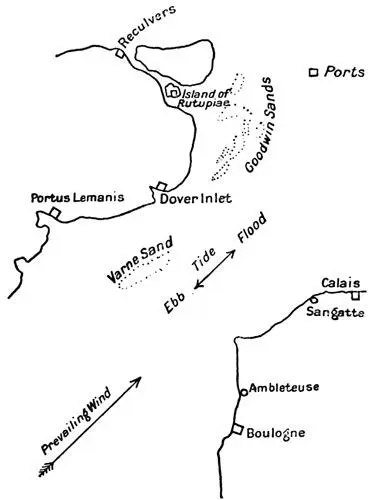That is the whole of my argument.
We have already seen how necessarily this corner of England will attract exit and entry. The most powerful emotion connected with that attraction was the sight of land. There is but one small section of the continental coast whence England, the sun shining on the chalk cliffs, can be clearly seen; and it can be so seen but upon certain days, say one day out of three. The little section lies between Sangatte and Ambleteuse. Here a great hill, whose seaward projection is the cape of Gris Nez, affords a good look-out, and hence I say that at least 120 days out of the year the further shore is visible. On rarer occasions it may be got beyond Calais on the east, and as far as the high sandhills near Etaples on the south and west.

Similarly there is but a small section of the Kentish coast whence the further shore can be seen. It extends from the South Foreland, you may say, to the hill above Folkestone; half a day's walk. There are days when you can see it as far north as Ramsgate Hill, but those days are rare; further west than Folkestone it is hardly ever seen (for the country is flat) save under conditions of mirage, such as startled the people of Hastings at the beginning of the nineteenth century.
There are from the continental side no good starting-points from the coast immediate to Gris Nez; it is rocky, uncertain, and unprovided with inlets. Calais, to the east, was probably the earliest port of departure. Here, at least, is a hole in the land, and there are two considerations which make it probable that the earliest men would start from this side of Gris Nez rather than the other. The first is that they could run as far as possible sheltered from the prevailing winds—for these come from the west and south-west; with such winds they would, up to the point of Gris Nez, be in calm water, while if they started from Boulogne they would have no such advantage. The second is that they could run with an ebb tide down to Gris Nez, and then if the wind failed so that they could not cross in one tide, the flood would be to their advantage when they neared the English coast. It would take them up again under lee of the land, round the South Foreland to Sandwich. From Boulogne they would have to start without shelter, run up on a flood tide, and if they missed that tide they might have drifted down again under the full force of the prevailing wind, any distance along the English coast. Boulogne ultimately became the principal port of exit and entry. It was certainly so used by the Romans; but Calais must, I think, have been the earliest starting-point.
From Calais, then, the run would have been made to the English shores.
But when we note the conditions of this corner of England several things strike us. In the first place, the number of the harbours. These included originally Winchelsea, Rye, the Portus Lemanis, Dover, Richborough, Reculvers; in all six harbours in this small stretch of coast. If we look at the place to-day we find something similar; men will attempt Rye, they will make Folkestone or Dover for choice; Sandwich at a pinch in quite small boats. Ramsgate after Dover gives the best of modern opportunities. There is something more. Most of these harbours were and are bad; most of them were and are artificial.
It is true that in ancient times the strait which divided the Island of Thanet from the mainland afforded an excellent shelter at either end. Reculvers was at one end, and the island of Rutupiae (Richborough) at the other. If one could not get into Richborough and was carried round the North Foreland, one could always beat round into Reculvers; but Dover was not much of a harbour; the Port Lemanis must have been open to the south wind and was probably very shallow; Rye, though better than it is now, was never a steep shore, and was always a difficult place to make. The modern harbours may, without exaggeration, be described as every one of them artificial. Folkestone is distinctly so. The old harbour of Dover has silted up centuries ago, and the gas works of the town are built over its site. Ramsgate would be of no value but for the two constructed piers.
Now what is the meaning of this multiplicity, and of all this interest in preserving such a multiplicity even by artificial means? The tide is the clue to the problem.
Consider a man starting from the continental shore to reach England; consider him sailing with a fresh breeze, for if the breeze was not fresh his chances of crossing in a reasonable time and of making any particular place of landing were small. Consider the fact that if he crossed in a fresh breeze that breeze would be, three times out of four, from the south or west. He runs under the lee of Gris Nez, and when he is beyond that point of rock, he gets into the short, sharp tumble of the sea which is raised by such a wind against the tide, for he has started at the ebb. He runs down with the wind abeam perhaps as far as the end of the Varne (where we now have the Varne Buoy), for the tide so takes him. He sees the water breaking and boiling at this shallow place. It settles near the turn of the tide. He holds on easily, making less westing and pointing well up to the shore. There opens before him a broad but very shallow lagoon with probably some central channel which he knows. He enters and has made the most favourable of the many crossings he knows. It is the Portus Lemanis—our Lympne.
But there are other chances. The wind might fail him, or the wind might so increase that he had to run before it. Did it fail him he would be caught by the flood tide some miles from land. He would drift up along the English shore, getting a few hundred yards nearer with every catspaw, and looking impatiently for some place to which he could steer. The dip in the cliffs at Dover would give him a chance perhaps. If he missed that he would round the South Foreland; he would have the advantage of smooth water, and he would make for the island Rutupiae, which stood at the southern entrance of the strait between the Isle of Thanet and the mainland. If his bad luck preserved, he might be swept up in what we now call the Gull Stream round the North Foreland; but the tide would have been making so long by this time as to be curling round Longnose, and even without the wind he could trust to it almost alone to make Reculvers. Similarly if the wind made him run before it and caused him to miss the Portus Lemanis, he would have the advantage of a weather shore once he was round the South Foreland, and could run with smooth water under him into Rutupiae.
With the prevalent winds, then, and the tidal conditions of the Straits, a multiplicity of harbours was a necessity for this crossing. In a tideless sea—such as the Mediterranean—one harbour, and one alone, would have absorbed the trade of Kent. Under our tidal conditions, a coast most ill-provided was compelled to furnish no less than six.
I could add, were I not afraid of confusing the reader, many other examples of this necessity. For instance, when one runs from the Belgian ports, or Dunkirk, to England, ever so little a change in the wind may make it necessary to go north above the North Foreland. Again, there is the barrier of the Goodwins, which, in spite of legend, is probably prehistoric. If you could not get well south of that barrier at the first trial you had to go north of it. Everything has compelled men, so far, to provide as many chances as possible upon this coast, and at the present day the breakwater at Folkestone, the desperate attempt which many still make to use the harbour of Rye, to some extent the great works of Dover, the poor relic of Sandwich, the continual improvement of Ramsgate, point to the same necessity. Perhaps some refuge less distant from the sea than the estuary of the Swale will be made again to replace Reculvers upon the north of the Kentish coast.
Читать дальше













